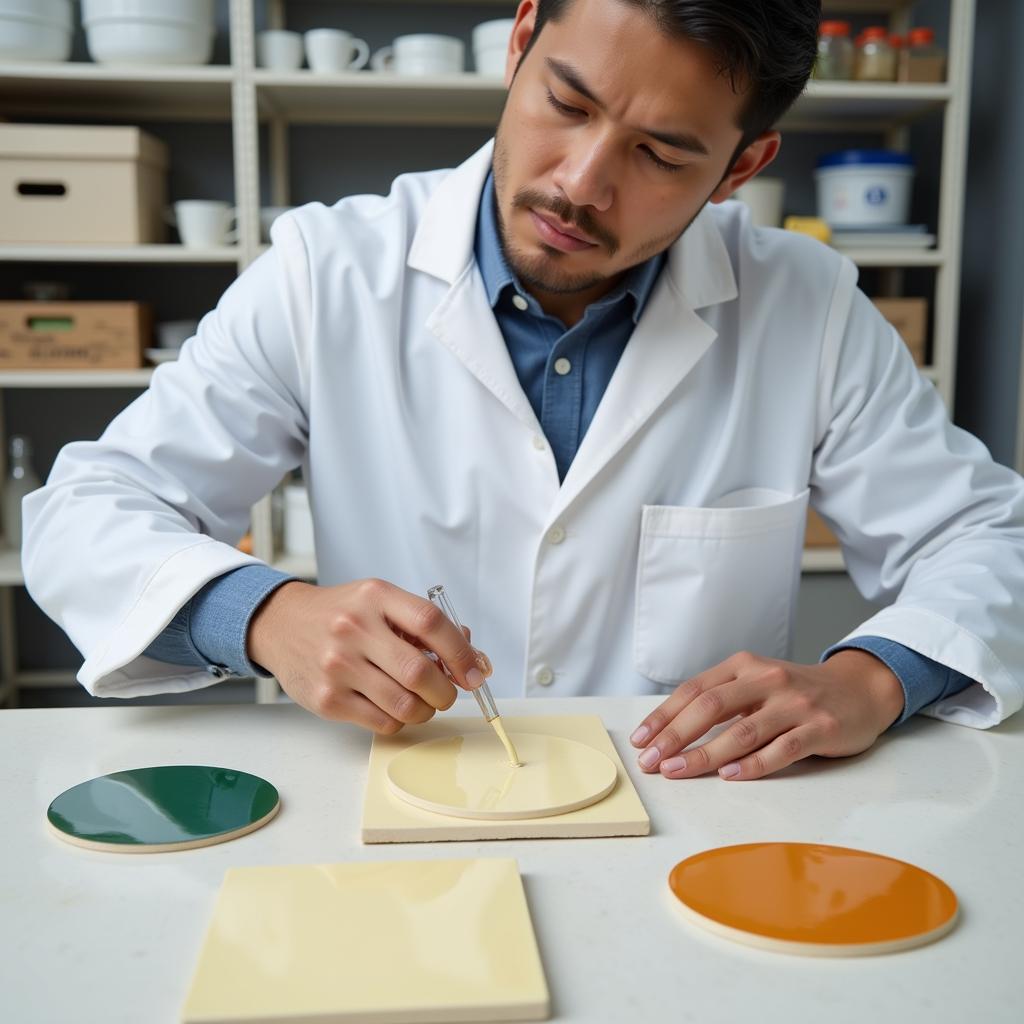Food Safe Ceramic Glaze is essential for any pottery intended for dining. Knowing which glazes are safe to use with food is crucial for both potters and consumers. This guide explores the importance of using food safe ceramic glazes, the potential risks associated with non-compliant glazes, and how to ensure your ceramic pieces are safe for enjoying your culinary creations.
Understanding Food Safe Ceramic Glaze
What exactly makes a ceramic glaze food safe? Food safe glazes are formulated to be free of harmful chemicals like lead and cadmium that can leach into food, especially acidic foods like citrus fruits and tomatoes. These glazes are tested rigorously to ensure they meet stringent safety standards. Using food safe clay glaze is essential for protecting the health of anyone using the pottery.
Why should I care about food safe glaze? Imagine enjoying a delicious meal, unaware that toxins are leaching into your food from the very plate you’re using. This is a real risk when using ceramics with glazes that haven’t been tested for food safety. The long-term health consequences can be serious.
Choosing the Right Glaze
Choosing the right food safe clay and glaze can be daunting. There are countless varieties available, each with unique properties and aesthetic qualities.
- Look for certifications: Many reputable manufacturers provide certifications ensuring their glazes are food safe. This documentation provides peace of mind and assures consumers that the product has been tested and approved.
- Test your glazes: If you’re unsure about the safety of a glaze, consider having it tested by a professional laboratory.
- Research: Thorough research is crucial when selecting glazes. Read reviews, consult with experienced potters, and explore online resources to gather information about different brands and their safety track records.
 Testing Ceramic Glaze for Food Safety
Testing Ceramic Glaze for Food Safety
Potential Dangers of Non-Food Safe Glazes
Non-food safe glazes can contain heavy metals that pose significant health risks. Lead and cadmium, commonly found in some glazes, can accumulate in the body over time, leading to various health problems. Using cat food plates with unsafe glazes can also harm our pets.
- Lead poisoning: Lead can cause neurological damage, developmental problems in children, and other serious health issues.
- Cadmium poisoning: Cadmium can damage the kidneys and bones and is also classified as a carcinogen.
How to Identify Food Safe Ceramics
Is it possible to identify food safe ceramics just by looking at them? Unfortunately, no. There’s no visual way to tell if a glaze is food safe. This is why relying on reputable manufacturers and certifications is so important.
What about vintage or antique ceramics? Older ceramics are more likely to contain lead or cadmium in their glazes. If you’re using antique pieces for dining, it’s a good idea to have them tested.
“When working with ceramics intended for food use, ensuring the glaze is food safe is non-negotiable. It’s about protecting the health and well-being of those who will enjoy your creations,” says Jane Doe, a ceramic artist and instructor with over 20 years of experience.
Making Your Own Food Safe Glaze
Many potters enjoy the creative freedom of making their own glazes. However, it’s crucial to be meticulous when formulating glazes for food contact. Accurate measurement and sourcing high-quality, food-safe ingredients are essential. is underglaze food safe is a common question and an essential consideration for potters.
Tips for Safe Glaze Making
- Use a reliable recipe from a reputable source.
- Double-check the safety of all ingredients.
- Document your process meticulously.
- Test your glaze after firing.
Conclusion
Using food safe ceramic glaze is paramount for protecting your health and the health of your loved ones. By choosing certified products, researching thoroughly, and following safety guidelines, you can ensure that your ceramic pieces are both beautiful and safe for enjoying your culinary creations. Remember that food safe acrylic paint is a different topic altogether. While related to crafting, its use and safety considerations are distinct from ceramic glazes.
FAQ
- How can I tell if a glaze is food safe? Look for manufacturer certifications or have the glaze tested by a lab.
- Are all commercially available glazes food safe? No, not all glazes are food safe. Always check for certifications.
- What are the risks of using non-food safe glazes? Heavy metals like lead and cadmium can leach into food and cause health problems.
- Can I make my own food safe glaze? Yes, but it requires careful research and precise measurement of ingredients.
- Where can I find food-safe glaze recipes? Reputable ceramic supply stores and online resources often provide safe glaze recipes.
- What should I do with old ceramic dishes that might not be food safe? Have them tested or avoid using them for food.
- Are there any alternatives to ceramic glaze that are food safe? Yes, there are other food-safe finishes available for pottery, but they have different properties and applications.
Other topics that might interest you: food safe clay glaze and is underglaze food safe.
If you have further questions about food safe ceramic glazes, please don’t hesitate to contact us. Call: 02437655121, Email: [email protected] or visit us at 3PGH+8R9, ĐT70A, thôn Trung, Bắc Từ Liêm, Hà Nội, Việt Nam. We have a 24/7 customer service team ready to assist you.